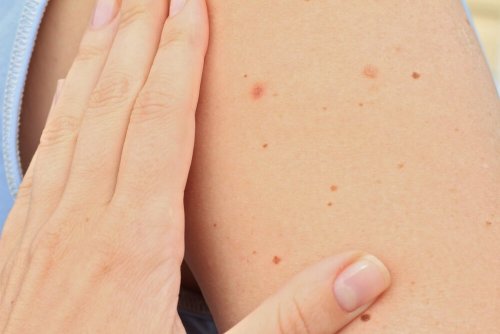Different Types of Birthmarks in Children

You may have noticed that your baby has a spot on his or her skin and you’re not sure if you should worry or not. These spots are usually different types of birthmarks in children, and, for the most part, aren’t a cause for alarm.
However, it’s always a good idea to keep an eye on them and consult a pediatrician. In some cases, they may have to do with certain illnesses.
Some birthmarks in children are hereditary and others simply form as a result of anomalies having to do with blood vessels or pigmentation. While we can’t do anything to prevent them, we can classify them by the cause behind their formation.
Types of birthmarks in children
Vascular birthmarks
These birthmarks form as the result of a malformation of the blood vessels. They’re red in color and come in three different types:
- Macular stains: These birthmarks are red in color and tend to appear on the eyelids, nose, lips, neck or head. They become more visible when children are exerting force (for example, when crying or making a bowel movement). For the most part, they disappear before a child’s second birthday.
- Hemangiomas: These birthmarks are strawberry colored and may be superficial or go deeper. In some cases, they may have a bluish tone given that they affect the blood vessels. They grow rapidly during the first months of life, but start to shrink and even disappear by the time a child is nine. Occasionally they may leave behind a scar, and they may appear in any part of the body.
- Port wine stain: These birthmarks get their name from the fact that they have a darker color, like red wine. While they can appear anywhere on the body, they’re more likely to occur in the face, neck, arms and legs. They tend to grow and don’t go away on their own. Rather, treatment is the only way to make them go away. Special care is required if they’re close to the eye, as they can damage vision.
Pigmented birthmarks
When the cells that give the skin its pigmentation grow excessively, they make way for these types of birthmarks. Again, there are three categories:
- Mongolian spots: These birthmarks are bluish in color and appear on the buttox region or lower back. They’re common among individuals of African, Hispanic and Asian descent. They go away on their own before the age of three – often sooner.
- Moles or nevi: Almost everyone has moles, but if we’re born with them, then they’re considered congenital. They may be large, small, flat, round, and even have hair. They’re more prone to developing melanoma (skin cancer), so it’s important to have a doctor observe them regularly. They’re brown or black in color.
- Cafe-au-lait: As their name indicates (in French), these stains are light brown in color, like that of coffee with cream. They can appear anywhere on the body. Cafe-au-lait birthmarks tend to multiply and grow along with the child. They don’t represent any sort of risk, though it’s good to have them looked at if they get larger. In that case, they may have to do with a genetic disorder called neurofibromatosis.

Should I see a doctor in regards to birthmarks?
Besides the circumstances we already mentioned above, you should also see a doctor in the case of bleeding, pain, itching, or infection. Keep the area clean with soap and water and cover it with gauze until a doctor can take a look at it.
Keep in mind that, while normal, you should also see a specialist any time a mole changes in shape, color, or texture. A doctor will be able to evaluate the changes and rule out any type of skin cancer.
For some birthmarks, the best course of treatment is laser treatment. Other birthmarks go away on their own. In the case of large moles, surgical removal is usually the best course of treatment.
As for port wine stains, the most common type of treatment is with a pulsed-dye laser. Patients must continue treatment over time as these birthmarks tend to reappear. However, if treatment starts at an early age, the dark red color can fade considerably.
You may have noticed that your baby has a spot on his or her skin and you’re not sure if you should worry or not. These spots are usually different types of birthmarks in children, and, for the most part, aren’t a cause for alarm.
However, it’s always a good idea to keep an eye on them and consult a pediatrician. In some cases, they may have to do with certain illnesses.
Some birthmarks in children are hereditary and others simply form as a result of anomalies having to do with blood vessels or pigmentation. While we can’t do anything to prevent them, we can classify them by the cause behind their formation.
Types of birthmarks in children
Vascular birthmarks
These birthmarks form as the result of a malformation of the blood vessels. They’re red in color and come in three different types:
- Macular stains: These birthmarks are red in color and tend to appear on the eyelids, nose, lips, neck or head. They become more visible when children are exerting force (for example, when crying or making a bowel movement). For the most part, they disappear before a child’s second birthday.
- Hemangiomas: These birthmarks are strawberry colored and may be superficial or go deeper. In some cases, they may have a bluish tone given that they affect the blood vessels. They grow rapidly during the first months of life, but start to shrink and even disappear by the time a child is nine. Occasionally they may leave behind a scar, and they may appear in any part of the body.
- Port wine stain: These birthmarks get their name from the fact that they have a darker color, like red wine. While they can appear anywhere on the body, they’re more likely to occur in the face, neck, arms and legs. They tend to grow and don’t go away on their own. Rather, treatment is the only way to make them go away. Special care is required if they’re close to the eye, as they can damage vision.
Pigmented birthmarks
When the cells that give the skin its pigmentation grow excessively, they make way for these types of birthmarks. Again, there are three categories:
- Mongolian spots: These birthmarks are bluish in color and appear on the buttox region or lower back. They’re common among individuals of African, Hispanic and Asian descent. They go away on their own before the age of three – often sooner.
- Moles or nevi: Almost everyone has moles, but if we’re born with them, then they’re considered congenital. They may be large, small, flat, round, and even have hair. They’re more prone to developing melanoma (skin cancer), so it’s important to have a doctor observe them regularly. They’re brown or black in color.
- Cafe-au-lait: As their name indicates (in French), these stains are light brown in color, like that of coffee with cream. They can appear anywhere on the body. Cafe-au-lait birthmarks tend to multiply and grow along with the child. They don’t represent any sort of risk, though it’s good to have them looked at if they get larger. In that case, they may have to do with a genetic disorder called neurofibromatosis.

Should I see a doctor in regards to birthmarks?
Besides the circumstances we already mentioned above, you should also see a doctor in the case of bleeding, pain, itching, or infection. Keep the area clean with soap and water and cover it with gauze until a doctor can take a look at it.
Keep in mind that, while normal, you should also see a specialist any time a mole changes in shape, color, or texture. A doctor will be able to evaluate the changes and rule out any type of skin cancer.
For some birthmarks, the best course of treatment is laser treatment. Other birthmarks go away on their own. In the case of large moles, surgical removal is usually the best course of treatment.
As for port wine stains, the most common type of treatment is with a pulsed-dye laser. Patients must continue treatment over time as these birthmarks tend to reappear. However, if treatment starts at an early age, the dark red color can fade considerably.
All cited sources were thoroughly reviewed by our team to ensure their quality, reliability, currency, and validity. The bibliography of this article was considered reliable and of academic or scientific accuracy.
- Vitoria Miñana, I. (2012). Trastornos cutáneos más frecuentes del recién nacido y del lactante. Dermatitis del pañal. Pediatria Integral. Disponible en: https://cdn.pediatriaintegral.es/wp-content/uploads/2012/06/195-208-Derm.pa%C3%B1al.pdf.
- CURE Communications Group. (2015). Melanoma.
- Instituto Nacional de Cancer. (2011). Lunares comunes, nevos displásicos y el riesgo de melanoma – National Cancer Institute.
- Carolina H, et al. Hemangiomas de la infancia, manejo actual. Revista Médica de Clínica Las Condes 2011;22(6):825-833. Disponible en: https://www.elsevier.es/es-revista-revista-medica-clinica-las-condes-202-articulo-hemangiomas-infancia-manejo-actual-S0716864011704953.
- Monteagudo B, et al. Prevalencia y características clínicas de la mancha mongólica en los recién nacidos del Área Sanitaria de Ferrol (España). Piel 2011;26(3):119-122. Disponible en: https://www.elsevier.es/es-revista-piel-formacion-continuada-dermatologia-21-articulo-prevalencia-caracteristicas-clinicas-mancha-mongolica-S021392511100013X.
- Rolón M, et al. Melanoma originado en nevus melanocítico congénito. Rev Asoc Col Dermatol 2008;16(4):305-306. Disponible en: https://revistasocolderma.org/sites/default/files/melanoma_originado_en_nevus_melanocitico-congenito.pdf.
- Duat A. Neurofibromatosis tipo 1. Pediatr Integral 2020; XXIV (6): 334–341. Disponible en: https://cdn.pediatriaintegral.es/wp-content/uploads/2020/xxiv06/05/n6-334-341_AnnaDuat.pdf.
This text is provided for informational purposes only and does not replace consultation with a professional. If in doubt, consult your specialist.








